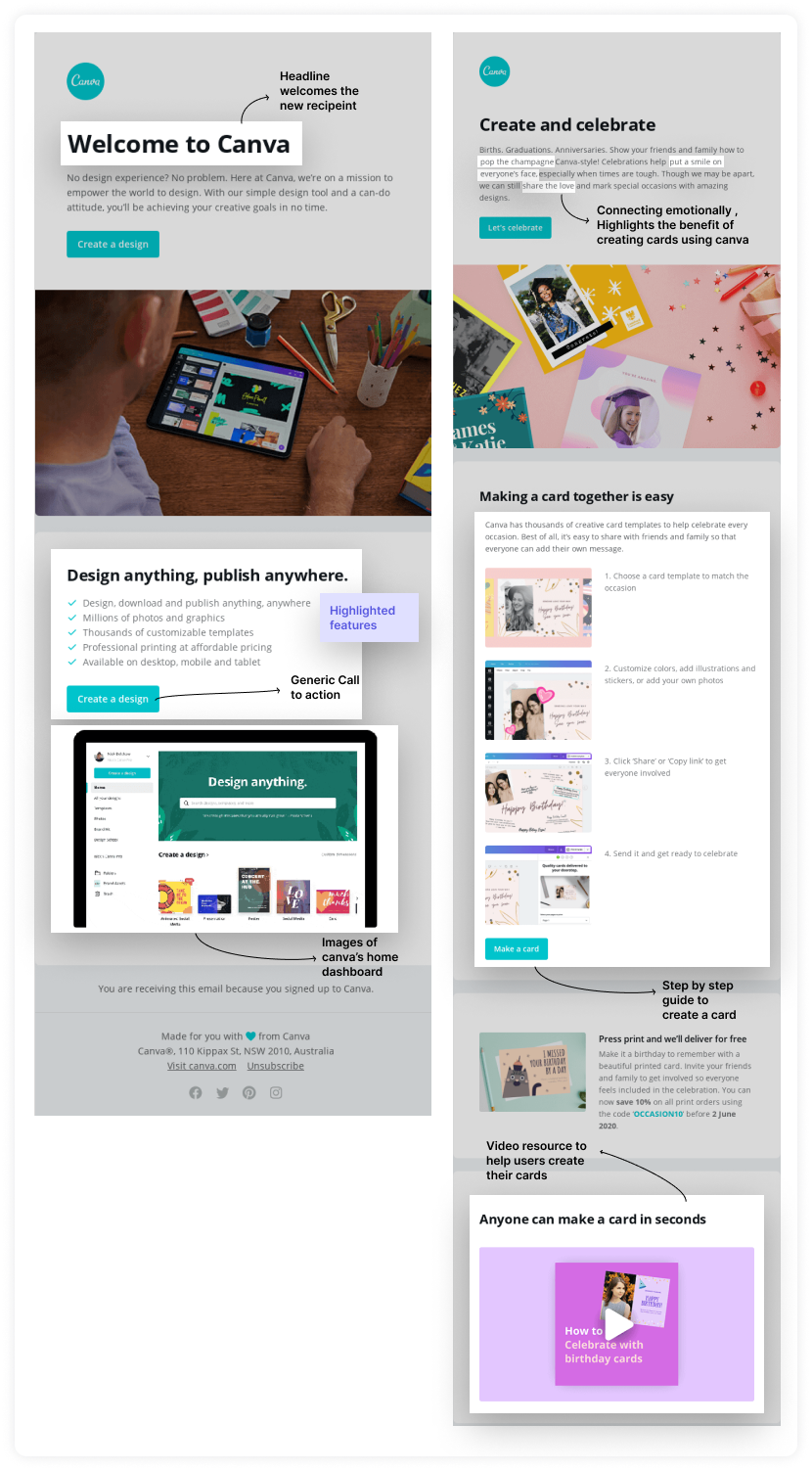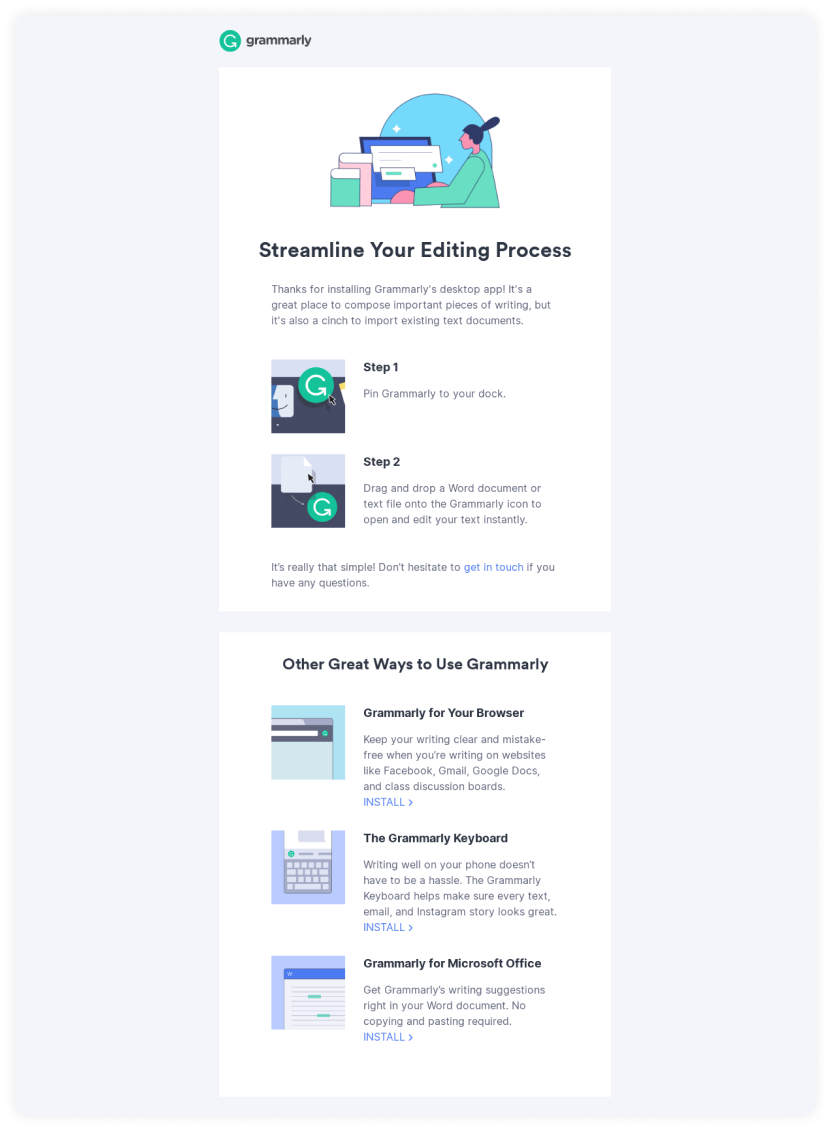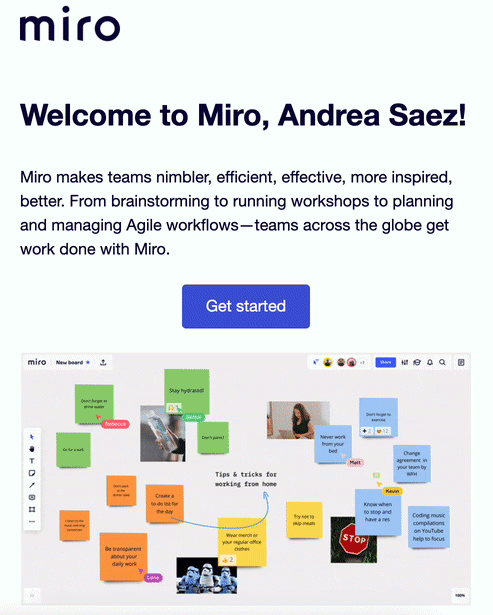Have you ever visited someone's home for the first time and been greeted with a warm welcome? Imagine receiving a house tour and endless conversations, and later you feel at ease like you've lived there for ages? That's the power of onboarding.
Likewise, your users are like your first-time visitors, and they need to feel at home with your brand. So, before you start bombarding them with emails, make sure they feel comfortable and know about the products/services you offer and how they can enjoy them.
That's what makes email onboarding an important part of your email marketing strategy. This guide will discuss the importance of onboarding emails and how to create them with examples and best practices.
Table of contents
- What are onboarding emails?
- Difference between welcome and onboarding email
- Why should you send onboarding emails?
- How to create an effective email onboarding sequence
- 4 non-negotiable onboarding email best practices
- Wrap up
What are onboarding emails?
Onboarding emails are sent after users sign up to educate them and walk them through the ins and outs of using your product or services.
But, like many people confuse jackets for coats (they are not the same folks), onboarding emails are often mistaken for welcome emails.
Difference between welcome and onboarding email
Generally, welcome emails are part of a larger user onboarding process and thank users for signing up. You can also share your brand’s features or stories in welcome emails.
Onboarding journeys are more detailed and help users understand the ins and out of your product or services. You can take users step by step and help them learn how to get the most out of your product/services.
Let's break down this difference using welcome and onboarding emails by Canva:

Why should you send onboarding emails?
Onboarding emails are a great way to show your users that you understand their pain points. Here's why:
• Educate and engage new subscribers
A new customer is like a first-time visitor to a city, and they've no idea where to begin their journey. They need help to explore and get familiar and to do that, they need a helping hand, perhaps a guide.
Similarly, a new customer is interested in your product/services and wants to explore them to solve their pain points. And user onboarding emails are a great way to do that. These act as guides for the users, walk them through step by step and get them all set up for their next adventure.
• Remove churn rate and improve customer retention
88% of people say they are more likely to stay loyal to a business that invests in email onboarding campaigns to welcome and educate them.
If users had a good experience in the initial stage of their buyer's journey, they're less likely to churn. Hence, higher customer retention.
• Convert leads into paying customers
If you're a B2B SaaS brand, chances are many of the users you onboard are on a free trial, and you wish to convert them into pro users. Well, email onboarding can help you do that.
With effective and relevant onboarding email, you can maintain communication with users, helping themselves solve their pain points and showing how they can get much more using a paid version.
How to create an effective email onboarding sequence
Every onboarding email you send might be because you want to get users familiar with your product/services, walk them through benefits they can get, and retain them. To achieve this goal, we have discussed steps to create an effective onboarding sequence:
Step 1: Segment your email list
Not all your subscribers are equal, and thus not the same email resonates with each one. A generic, non-segmented email will not get you the results you want. So, your first step should be to identify your target or buyer persona.
There are four segmentation techniques you can use to build or identify your target persona:
| Technique | Example |
|---|---|
| Demographic | Age, gender, education, profession, company, and ethnicity. |
| Geographic | Country, city, and pin-code. |
| Psychographic | Social status, personality, lifestyle, habits, and values. |
| Behavioral | Interaction with your brand - Active or non-active, past purchase history, the reasons for signup, etc. |
You can get this data using the web, email, or CRM analytics. Once you have this data, you can develop your target persona, which will help you create targeted onboarding campaigns.
There is another approach to segment - Simply ask your subscribers.
Use the two super easy ways:
1. Use welcome emails
You use welcome emails to thank users for signing up, tell your brand stories, and highlight features. But why not use it to get insights into users' preferences?
Sleeknote sends this welcome email when users signup. Whenever the recipient clicks on any links, they get added to the respective onboarding flow created for such users.
Source: Sleeknote
Your welcome emails can give you further insights into segmentation. For instance,
You sent a welcome email one then looked at the open and click-through rate to segment.
If users opened but didn't click, send them an email after 2 days with a different subject line to prompt them to open and click on any links.
If they didn't open it, send them an email with a different subject line and email copy emphasizing the importance of segmentation.
If users didn't take any action in both cases, you could put them in a different segment of inactive users.
2. At the point of signup
Another way is to use signup forms to segment users.
For example, you can create a landing page with a lead magnet to encourage users to sign up to access free resources. You can include questions like the company they work at, industry, role, country, etc.
In the examples below, Sleeknote and Litmus use signup forms to allow their audience to self-segment. While Sleeknote asks for users' industry, Litmus asks about their company name, country, job title, and ESP they use.
Step 2: Create relevant onboarding email flow
Once you have your segments ready, it's time to create an onboarding flow for each segment that is relevant and valuable to that specific segment. While creating the user onboarding emails, pay close attention to the following elements:
1. Subject line
Email subject line is the most powerful tool in your arsenal to help you get more open, but only if you know how to write it creatively. The subject line should create curiosity, grab users' attention in their crowded inbox, and compel them to open the email immediately.
Here are some tips for writing compelling subject lines:
- Target user's pain point and offer a solution
Example by Canva: Skip the blank canvas— kickstart ideas with a template.
- Clarify what they can expect in the email
Example by Framer: Hi there—here's how to get started on your first prototype.
- Combination of value + benefit
Example by Pitch: ✨ 3 easy steps to create a great deck.
2. Email copy and design
You need to see your product/brand for email copy and design through new users' lenses.
What pain points do they have, and how does your product help them solve them? What's the first step they should take to get the success they are looking for? Which tone should be eBay for them? These questions will help you write email copy that resonates with the users and direct them in the right direction.
Here are some best practices you should follow while creating your emails:
Be relevant in your email copy
Make your emails as relevant as possible to the recipient's pain points and how they can solve them using your product/services. Relevance can skyrocket your onboarding engagements if you show the right message to the right user at the right time.
Use a conversational tone and make the recipient the hero of your email by using more of "You" and less of "I" or "We."
Avoid asking users to do the heavy lifting of figuring out how your brand benefits them. Instead, act like a guide and walk them through each step as clear as possible, just like Grammarly does in this email:

Focus on your Aha! Moment
It is critical to make people realize the value and benefit they can get using your product/services. Users are unfamiliar with the tools, user interface, and navigation, and they're looking for cues that can guide them to get what they signed up for.
Your copy should help them realize the " aha moment" - the moment where the value and benefit of your product become clear to them.
Each email should be well-crafted that take users through a smooth ride over your product/services.
- Use videos and GIFs to show your product/services in action, as Miro, a team collaboration software, does.

Source: Google
Describe each step meticulously to help users realize the value they will get.
Highlight features that are specific to users' pain points. For example, if users signed up to create a flowchart on your platform, show them exactly that.
3. Clear call to action
End your onboarding tour with a clear and specific call to action that users should take to get on the next step. For example, you can share help documents or contact details if they face any issues.
Always ensure that each onboarding email only has one specific call to action.
4 non-negotiable onboarding email best practices
Here are 4 best practices to create a value-packed customer onboarding experience:
1. Deliver what you promised.
Ensure that all emails are created to deliver what you promised to the user. Your emails should help them achieve what they want by using your product/services.
2. Use personalization to build connections
Onboarding emails get users familiar with your brand, build connections, and build a loyal customer base. To build such a long-lasting connection, you need to personalize emails as if you're writing to your close friend. The recipient should feel like they are heard.
3. Show social proof to build credibility.
New users might be skeptical about using your product/service even though they signed up for a free trial. You can resolve this skepticism by showing social proof - testimonials, case studies, etc. You shouldn't give any reason to users to doubt your brand because the more they trust you, the more credibility you'll develop, and thus, you'll be able to retain them.
4. Make emails easy to digest
They are less likely to read a long email copy if you're onboarding a new customer. Since they're in the initial stage of the funnel, you need to make your copy more digestible and less intimidating. You don't want to scare them away, right?
So, try to use GIFs, relevant emojis, enough white space to make your customer's journey a little less boring and more fun.
Wrap up
Customer onboarding is not a one-time setup to get customers familiar with your brand. Instead, it’s an ongoing process to help them explore your product or services and improve their lives. In Samuel Hulick's words,
"Onboarding is not so much about making a positive initial introduction. It is an overarching approach to helping your customers become better versions of themselves"
Along with onboarding, you should also nurture these customers throughout their journey with your brand. We recommend you read our guide on nurturing leads using different email campaigns to maintain healthy communication and make them an important part of your brand.
What you should do next
Hey there, thanks for reading till the end. Here are 3 ways we can help you grow your business:
Talk to an email expert. Need someone to take your email marketing to the next level? Mailmodo’s experts are here for you. Schedule a 30-minute email consultation. Don’t worry, it’s on the house. Book a meet here.
Send emails that bring higher conversions. Mailmodo is an ESP that helps you to create and send app-like interactive emails with forms, carts, calendars, games, and other widgets for higher conversions. Sign up now and send 10k free emails/month. Sign up here.
Get smarter with our email resources. Explore all our knowledge base here and learn about email marketing, marketing strategies, best practices, growth hacks, case studies, templates, and more. Access guides here.

